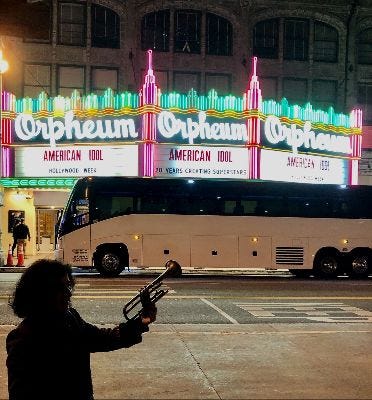Jewish Identity in Hollywood
A New Scroll of LA Jewish News
Folks,
A panoramic view of Fairfax was what I found atop the new Academy Museum of Motion Pictures. Located in the former May Company building on the corner of Wilshire and Fairfax, I could see from my perch the area that still remains a center of Jewish thought, prayer, remembrance, commerce, and habitation. How the museum will relate to that historic community, as you will read in my column, remains an open question. From the Academy’s inception (according to its own account), in 1927 when “Louis B. Meyer, head of MGM, discussed the idea of motion picture trade organization,” Jews have been in Hollywood’s picture. Hopefully, soon, the museum will help everyone to see it.
As for MegilLA’s picture, I need you to see that as well. Without your subscription, I cannot stay on the screen. Your subscription will help keep this publication from fading to black. If you have been enjoying but not paying, it’s time. If you have been putting it off, it’s time. Please buy your ticket to a fresh and creative form of Jewish journalism. Subscribe today.
Shabbat shalom.
Edmon J. Rodman
////\/\\\\
////\/\\\\
GUIDE FOR THE JEWPLEXED
There are Jews at
the Academy Museum,
but you need a program
Edmon J. Rodman
This year, if there was an Academy Award given for Best Cover-up of Jewish Identity, it would go to the new Academy Museum of Motion Pictures.
The press, most notably in a story in Rolling Stone, has criticized the museum for not telling the story of how Jewish showmen were among the first players in Hollywood, and I was anxious to see if this report was accurate.
Alas, on a recent visit, I searched for that foundational film business history and found only a brick or two. What I did find was that Jews are in the picture, but you need a program to know the players. They are hidden in the crowd, as Jews often are without identification, contrasting with the portrayals of Hayao Miyazaki, Pedro Almodovar, Spike Lee, and Bruce Lee whose ethnic identities come through clearly.
It's not that the stories of other ethnic minorities should have been diminished, they are important, inspiring stories. But in a new institution that tells you right up front in its initial guide that it’s multi-floor core “presents of the celebratory, complex, diverse and international stories of filmmakers” and the works they created, why were so many historic Jewish filmmakers passed over, and the identity of those Jewish filmmakers included in the exhibit edited out?
The Academy Museum is not a Jewish museum; I get it. But while taking in the view of the Fairfax area from the museum’s rooftop terrace, I wondered how the Academy, which put its museum in a former department store (May Co) built by Jews and designed by Jewish architect Samuel Abraham Marx in a Jewish neighborhood, and renamed it after a wealthy Jewish philanthropist couple Haim and Cheryl Saban, who donated $50 million to the museum project, could think they could pass over the industry’s Jewish roots.
In a digital information age when the biographies of Jewish directors, screen writers, actors, songwriters, movie moguls, is well-known, did the Academy’s decision makers think the omission would somehow slip by?
Floor by floor, it became clearer, that in Jewish terms, the museum’s initial offerings were more of a beating of the chest, a token of atonement for the Academy’s historic lack of diversity, than an attempt to tell an honestly inclusive story.
However, like walking into a darkened theater, once my eyes adjusted, Jews, though unidentified and their struggles left untold, began to light up my view.
Why unidentified? Probably because museum curators, have traditionally been reluctant to identity artists by their Jewish heritage, seeing their ethnic identity as not germane.
But that doesn't need to be the way it is.
More contemporary scholarship, exemplified in the 2010 book “Jewish Dimensions in Modern Visual Culture” takes the view that knowing that an artist is Jewish is important if we are to understand the societal forces like anti-Semitism, and assimilation (recall how many Jewish actors changed their Jewish surnames) which may have had an impact on their struggles entering or thriving within their chosen profession.
For example, on the fourth floor, I found among a series of photographic portraits of women who “achieved significant ‘first’ in the history of cinema and the Academy Awards,” a photo of Barbra Streisand.
The accompanying text tells us that she was the first woman “to direct, produce, write, and star in major studio film “Yentl,” (See a clip HERE ) and that she won an Oscar for Best Actress for “Funny Girl.”
The text doesn’t say that she is Jewish, but if it added that her grandfather had been a cantor, that she grew up poor in Brooklyn, or that she began her education at the Jewish Orthodox Yeshiva in Brooklyn, our understanding of her work would be seen in a clearer cultural context.
Others in the museum like animator Max Fleischer— known for his studio’s Betty Boop and Popeye cartoons, and for his patent of the rotoscope, a device used to trace live action footage— have Jewish stories less-well known than Streisand’s, and need cultural identification as well.
Adding to our understanding of his life would be the knowledge that Fleischer was a Polish Jew born in Krakow whose father was a tailor. He came to the US at age five and eventually received a commercial art degree from Cooper Union. Knowing Fleisher was a Jew also helps to explain why Betty Boop, in the cartoon “Minnie the Moocher,’ “Watch it HERE) has a father who wears a kippah, and insists she eat ethnic food.
As part of an exhibit covering “the Wizard of Oz,” the museum goer is introduced to composer Harold Arlen and lyricist E. Y. “Yip” Harburg, who as a team wrote all the songs for the movie including the Academy Award winning “Over the Rainbow.” (Listen HERE)
Adding to our understanding of the roots of this American classic would be that both were Jewish and had changed their names. Harburg was born Isidore Hochberg and Arlen was born Hyman Arluck. Adding more background to the feel of the composition would be that Harburg was a lyricist of socialist leanings from an Orthodox family, and that Arlen was the son of a cantor.
Yet, there is good news from not-too-far over the rainbow. The Academy Museum has heard the geschrei, and they announced that in late spring of 2023, the museum will open its first permanent exhibition Hollywoodland, which will chronicle the founding and the founders of the Hollywood studio system.
Will that exhibit put in cultural context the work of such Jewish founders as, Adolph Zukor, Louis B. Mayer, and brothers Jack, Harry and Sam Warner, Carl Laemmle as well as others? I will be watching the coming attractions.
Until then, to help sustain your understanding and joy in the Jewish contributions to Hollywood, go into the museum’s restaurant. Called Fanny’s, it is named after Jewish comedienne, singer and radio, theater and film actress Fanny Brice (Fania Borach), who inspired “Funny Girl.”
A few moments spent perusing a wall of photos from her career that are displayed in the restaurant, will make the Academy Museum’s omissions just a little bit easier to swallow.
////\/\\\\
////\/\\\\
Downtown walk sparks
LA Jewish story
The lights of LA's Jewish past spark to life in a new downtown walking tour. Over the last year, I have been researching this unknown story, walking the street, collecting artifacts, and getting a feel for the Jewish life that once flourished there. To share that work with you, I will be leading a walking tour of the street called “Jewish Lights Over Broadway" on Sunday, April 24 from 7 to 9 p.m. (RESERVATIONS REQUIRED, make them HERE)
The tour, organized with the Museum of Neon Art in Glendale, illuminates how the Jewish entrepreneurs of Broadway, many of them immigrants, filled the street with bright lights, and the city’s homes with music, the latest in fashion, and the staples required to satisfy a hungry, growing city.
////\/\\\\
Taking the measure
of a Hollywood costumer
Costumes for "Suicide Squad" by costume designer Judianna Makovsky.
The costume designs of Judianna Makovsky are featured at the FIDM Museum in their annual Art of Costume Design in Film show. The show which runs until June 4, 2022, includes four of Makovsky’s costumes for “Suicide Squad.”
Born on August 24, 1955, as a child she joined the Metropolitan Opera ballet and children's chorus but was always more interested in what went on backstage to produce a show.
A graduate of the Art Institute of Chicago and Yale Drama School, Makovsky, who is Jewish, is best known for her work in “Harry Potter and the Philosopher’s Stone,” and “Hunger Games.” Her designs have been nominated three times for Academy Awards.
For inspiration for the Capitol costumes in “Hunger Games,” according to the L.A. Times, Makovsky “looked at Italian Fascist architecture.”
Along with other Jewish costume designers such as Adrian (Max Greenberg), Edith Head, Helen Rose, Albert Wolsky, Michael Kaplan, and many others, examples of her work were included in the UCLA 2019 show “The Jewish Thread: The Hidden History of Costume Design in Hollywood.”
////\/\\\\
Seen On the Way: The Garment District
A week when LA rolls out the red carpet is a fitting time to revisit Academy Award Clothes, the once-venerable downtown men’s clothing store.
Opened in 1949 by Jules J. Kaplan, and a partner whose interest he bought out within the first year, the store was first located at 901 S. Broadway, in an area that had several other men’s wear stores.
Quickly finding an audience for good quality discounted suits, Academy Award Clothes, from the late 1970s to the mid-1980s, employed 45 people and earned more than $5 million in sales annually.
Known within the Jewish community as a place where a guy could get a good suit at a fair price, It was the place I went, along with my father, in 1980 to buy a wedding suit.
Since the shop held on to old inventory, the store was popular with TV and motion picture clients looking for costumes. Academy supplied suits for television shows such as “Mad Men” and “Six Feet Under” and films such as “Spiderman,” “Dirty Harry,” “Rush Hour,” “Die Hard” and “Terminator.”
The store was also the source for iconic gold-colored jackets for Century 21, and blazers for USC marching band.
Kaplan started the store almost as a fluke. A former New York attorney, his introduction to the men’s fashion business began during a cross-country family road trip to California. As a favor to his garment manufacturer brother, he sold some clothes out of his car.
Later, when Kaplan had problems getting his brother’s merchandise into a downtown store, he decided to open his own.
Well-known among the Jewish men’s wear sellers in downtown, in 1970, Kaplan was chairman of United Jewish Welfare Fund’s Men’s Wear Section.
Mostly as a result of a change in business attire and men requiring fewer suits, the store closed in 2008, though Peter Kaplan, Jules’ son, still owned the building.
As for the business’ name, for decades, according to California Apparel News, lawyers for the Academy of Motion Pictures Arts & Sciences, occasionally issued letters demanding the clothier change it. Kaplan never changed the name, and the lawyers never sued.
As for my wedding suit, I have been married 41 years, and it still fits.
////\/\\\\










